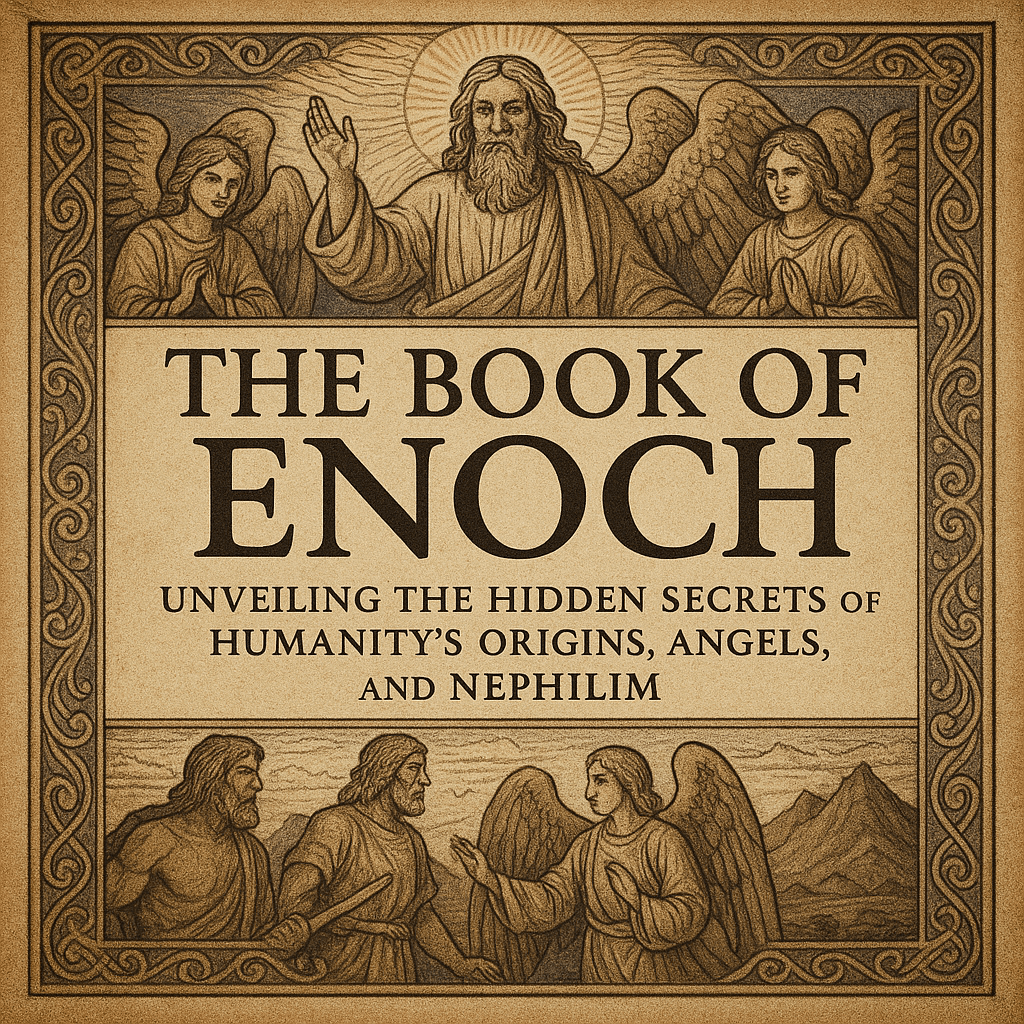The Book of Enoch is one of the most mysterious and controversial texts that have ever been excluded from the Bible. Despite being omitted from the sacred scriptures of both Judaism and Christianity, it contains a wealth of secrets about fallen angels, giants, and apocalyptic visions that challenge traditional religious doctrines. This article delves into the mysteries of the Book of Enoch, revealing the deep spiritual insights it holds about humanity’s origins, the dark side of divine beings, and the origins of evil on Earth.
Table of Contents
What Is the Book of Enoch?
The Book of Enoch is an ancient religious manuscript that provides an alternative narrative to the familiar Bible stories. It has been a subject of intrigue for scholars, theologians, and conspiracy theorists alike. Written in various sections between the third century BC and the first century BC, this text focuses primarily on the teachings of Enoch, the great-grandfather of Noah.

Enoch’s mysterious journey into the divine realms, his interactions with angels, and his foretelling of apocalyptic events challenge much of what is traditionally understood in mainstream religious teachings. Its origins trace back to the Jewish traditions of the Second Temple period, a time when many different sects and religious factions were interpreting and rewriting the Bible.
The Forbidden Nature of the Book
So why was the Book of Enoch banned from the Bible? To answer this, it is essential to understand the controversial content that led to its exclusion. The text presents narratives that conflict with the canonical scriptures. For instance, it describes fallen angels, known as the Watchers, who descend to Earth and create a hybrid race of giants, the Nephilim, by mating with human women. This notion directly contradicts the Bible’s teachings on the nature of angels and their divine purity.
Beyond this, the Book of Enoch introduces apocalyptic prophecies and divine judgments that are much more graphic and intense than those found in canonical texts like the Old and New Testaments. Some early Christian leaders, fearful of the potential theological implications, chose to suppress this book to maintain doctrinal consistency.
Enoch: The Mysterious Figure of the Bible
Enoch himself is a figure who stands out in the Bible. In Genesis 5:18-24, he is described as the seventh generation from Adam, and unlike most others in the genealogy, Enoch does not die. The text says that “Enoch walked with God; then he was no more, because God took him away” (Genesis 5:24). This statement stands as a testament to Enoch’s deep spiritual connection with the Creator. He is one of only two individuals in the Bible—along with Elijah—who did not experience death but were taken directly to heaven.
In Hebrews 11:5, it is emphasized that Enoch “did not experience death,” which further establishes his significance as a righteous figure. The Epistle of Jude (Jude 1:14-15) even references Enoch as a prophet who foretold the coming judgment of the wicked. These references are some of the few canonical mentions of Enoch, and they further highlight the importance of his role in biblical prophecy.
Divisions of the Book of Enoch
The Book of Enoch consists of five distinct sections, each contributing unique elements to its overarching narrative. These sections delve into celestial secrets, angelic rebellions, and the ultimate fate of humanity.
1. The Book of the Watchers
The first section of the Book of Enoch, The Book of the Watchers, tells the story of a group of angels, known as the Watchers, who descended to Earth and took human wives. These angels, led by Semjaza, were responsible for teaching humanity forbidden knowledge, including the art of warfare, sorcery, and astrology. Their actions led to the birth of a race of giants known as the Nephilim, who caused havoc on Earth.
The Watchers’ actions angered God, and they were punished by being bound and cast into the abyss, awaiting their final judgment. Enoch serves as the intermediary between God and the fallen angels, delivering God’s judgment to the rebellious beings. This section emphasizes the consequences of spiritual rebellion and the abuse of divine knowledge.
2. The Book of Parables (Similitudes of Enoch)
The second section, The Book of Parables, is a collection of three prophetic parables that reveal the coming judgment upon the wicked and the ultimate redemption of the righteous. It highlights the figure of the Son of Man, a Messianic figure who will execute divine justice at the end of days. The parables describe a cosmic battle between good and evil, with the righteous being rewarded and the wicked punished.
This section is notable for its portrayal of a pre-existent Son of Man who is described as being with God before creation. It aligns with early Christian teachings about the role of Christ as a divine judge.
3. The Astronomical Book
In The Astronomical Book, Enoch is guided through the heavens by the archangel Uriel. This section details the divine order of the cosmos and introduces a solar calendar of 364 days, divided into four equal seasons of 91 days each. This calendar is distinct from the lunar calendar traditionally used in Jewish culture.
The Astronomical Book also provides insights into the movements of the stars and the heavenly bodies, emphasizing that the cosmos is governed by divine principles.
4. The Book of Dreams
The fourth section, The Book of Dreams, presents Enoch’s visionary dreams that span from the creation of the world to the apocalyptic end times. This section uses allegorical imagery, such as white bulls representing the righteous and black bulls symbolizing the wicked, to illustrate the ongoing struggle between good and evil.
The Book of Dreams also contains a detailed account of the Maccabean Revolt (163-142 BC), a historical conflict that took place in the intertestamental period. This section underscores the importance of divine justice and the ultimate triumph of righteousness.
5. The Epistle of Enoch
The final section, The Epistle of Enoch, contains moral exhortations, prophecies, and divine revelations addressed to Enoch’s son Methuselah. It foretells the destruction of the wicked and the reward of the righteous, urging humanity to remain steadfast in their faith and obedience to God.
Theories Behind Its Banishment
There are several reasons why the Book of Enoch was excluded from the biblical canon. One of the primary factors was its vivid depiction of fallen angels and their interactions with humans, which conflicted with mainstream religious teachings. The notion of celestial beings mating with human women to produce hybrids was considered heretical by early church leaders, as it contradicted the purity of angels and the divine creation of humanity.
Additionally, the intense apocalyptic visions and graphic descriptions of divine judgment raised concerns about the speculative nature of the text. The Book of Enoch’s portrayal of a cosmic battle between good and evil was far more explicit and dramatic than the judgment narratives found in canonical texts.
Another factor in its exclusion was the elevation of Enoch as a prophet who received direct revelations from God. This challenged the hierarchical structure of prophetic authority in mainstream religious traditions, which reserved prophetic status for figures like Isaiah, Jeremiah, and Ezekiel.
Modern Interpretations and Theories
Some modern theorists and alternative historians have proposed that the Book of Enoch contains references to extraterrestrial beings and advanced technologies. The descriptions of angelic beings, their descent to Earth, and their imparting of forbidden knowledge have been likened to accounts of UFO sightings and alien encounters. Some believe that the Watchers were not angels at all but extraterrestrial visitors who shared advanced technologies with humanity.
Despite its exclusion from most biblical canons, the Book of Enoch has survived in various religious traditions, most notably in the Ethiopian Orthodox Church. It continues to captivate readers and scholars with its blend of ancient wisdom, mystical visions, and theological implications.
Conclusion: The Enduring Legacy of the Book of Enoch

The Book of Enoch remains one of the most fascinating and enigmatic texts from antiquity. Its vivid depictions of angels, giants, and cosmic battles offer a unique perspective on the nature of good and evil, divine judgment, and humanity’s origins. Although it was banned from the Bible, the Book of Enoch continues to intrigue and inspire those seeking to uncover the mysteries of our spiritual and historical past.
Whether viewed as a product of apocalyptic imagination or as a preserved fragment of ancient knowledge, the Book of Enoch remains a powerful testament to the enduring quest for truth and understanding in the face of divine mysteries.
